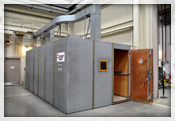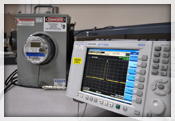
AEP Dolan Technology Center staff has the experience and capability to assist customers in creating requirements documents that can be used within the request-for-pricing (RFP) process. Requirements documents are normally organized according to the various architectural and standards layers as can be found in the OSI model. For example, at the application layer, requirements can be directly mapped and customized to specific demand response programs such as multi-tiered metering and rate programs, critical peak pricing and load control programs. These requirements documents can also be utilized as the basis for the creation of customized test plans.
Customized Test Plans
The AEP Dolan Technology Center staff has the skill set to create custom test plans that showcase end-to-end testing of Demand Response systems. These custom test plans take into account overall system architecture, installation layout possibilities, and various network configurations in order to fully vet how these systems will actually perform within their intended environment. The construction of these custom test plans also details how AEP approaches the domain of interoperability by testing for semantic meaning, syntactical understanding, network interoperability, and basic connectivity as defined by the Department of Energy’s GridWise Architecture Council (i.e. GWAC stack).
Physical/MAC Layer Testing

AEP uses a 42.5 cubic meter electromagnetically-shielded room (Faraday cage), smaller Radio Frequency (RF) shielded test enclosure and various RF test equipment to test radio transceiver performance under a wide range of conditions such as interference, coexistence, and a variety of real-world scenarios including system response to failure.
AEP accomplishes this testing by evaluating devices and systems against industry standards such as IEEE 802.15.4, IEEE 802.11, and IEEE P1901.
AEP has two fully functional AMI systems available for test:
- Landis+Gyr’s Gridstream Suite®
- Silver Spring Networks’ Utility IQ Advanced Metering Manager® and Demand Response Manager®
Network/Transport/Application Testing

AEP has the ability to take a particular protocol specification and effectively perform testing on secure communication transactions to ensure that the protocol rules and sequence are being followed under normal and abnormal conditions.
AEP accomplishes this using specialized test equipment for network and packet sniffing including:
- IEEE 802.15.4 including ZigBee Pro
- ZigBee Smart Energy Profile 1.x
- Smart Energy Profile 2.0
- IEEE 802.3 Ethernet
- IEEE 802.11 WiFi
- Internet Protocol (IP) over various physical layers
Syntactic Protocol Testing
AEP has the ability to take a particular protocol specification and effectively
perform testing on secure communication transactions to ensure that the protocol
rules and sequence are being followed under normal and abnormal conditions.
End-to-End Analysis and Reporting Against AMI Systems
- Landis+GYR Gridstream
- Silver Spring Networks Demand Response Manager
Equipment Performance
AEP can apply our end-to-end Demand Response testing expertise to help evaluate new technologies and products, provide statistical models of expected performance, and even quantify any risks associated with new development.
Product specifications can be verified by testing prototypes or final products for conformance with specifications and industry standards. When desired, we can run selected test cases numerous times and provide statistical calculations including confidence intervals and margin of error. For those evaluating or considering deployment of new technologies, AEP can help identify the risks involved in such a decision.
In particular, vendors interested in a review of their products can have AEP test and evaluate their samples. In order to supplement certifications performed by official test houses, AEP offers testing in real world scenarios which can include loss of communications or power, and other abnormal operating conditions.
AEP can document and report on each step in the testing process – from executing individual test cases, sequencing through a comprehensive test plan, to documenting actual test runs and summarizing the final results, while simultaneously providing a variety of artifacts such as captures of protocol sniffing, photos/videos (optical, infrared, and high speed formats), and detailed statistical analyses of the results.
Through these and other approaches, AEP can help you identify and manage equipment performance issues.
Case study: Load Control Switch Testing
As an example, AEP has tested the long-term reliability of load control switches (LCS) used to provide Demand Response load shedding. By automating the actuation and status monitoring of the LCS, accelerated life testing was completed. Tens of thousands of cycles were performed with both resistive and motor loads (e.g. pool pump). Statistics derived from the test results were of significant value to the operating utility.
Energy Modeling

Implementation of any Demand Response approach involves forecasting of the effectiveness of proposed tariffs. AEP staff has the expertise to analyze such proposals, perform appropriate testing in our lab, and use these test results to model expected results of the proposals. AEP has the experience to quantify the Demand Response behavior of appliances in multi-tiered pricing programs. AEP’s laboratory grade metering instruments can track demand (kW) and energy (kWh) over very fine time intervals during Demand Response actions.
By providing such analyses, AEP can provide valuable input to the overall Demand Response planning and decision-making process.